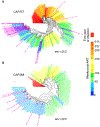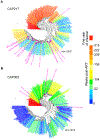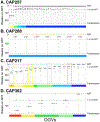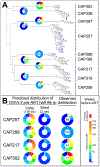The replication-competent HIV-1 latent reservoir is primarily established near the time of therapy initiation
- PMID: 31597754
- PMCID: PMC7233356
- DOI: 10.1126/scitranslmed.aaw5589
The replication-competent HIV-1 latent reservoir is primarily established near the time of therapy initiation
Abstract
Although antiretroviral therapy (ART) is highly effective at suppressing HIV-1 replication, the virus persists as a latent reservoir in resting CD4+ T cells during therapy. This reservoir forms even when ART is initiated early after infection, but the dynamics of its formation are largely unknown. The viral reservoirs of individuals who initiate ART during chronic infection are generally larger and genetically more diverse than those of individuals who initiate therapy during acute infection, consistent with the hypothesis that the reservoir is formed continuously throughout untreated infection. To determine when viruses enter the latent reservoir, we compared sequences of replication-competent viruses from resting peripheral CD4+ T cells from nine HIV-positive women on therapy to viral sequences circulating in blood collected longitudinally before therapy. We found that, on average, 71% of the unique viruses induced from the post-therapy latent reservoir were most genetically similar to viruses replicating just before ART initiation. This proportion is far greater than would be expected if the reservoir formed continuously and was always long lived. We conclude that ART alters the host environment in a way that allows the formation or stabilization of most of the long-lived latent HIV-1 reservoir, which points to new strategies targeted at limiting the formation of the reservoir around the time of therapy initiation.
Copyright © 2019 The Authors, some rights reserved; exclusive licensee American Association for the Advancement of Science. No claim to original U.S. Government Works.
Conflict of interest statement
Figures





References
-
- Finzi D, Hermankova M, Pierson T, Carruth LM, Buck C, Chaisson RE, Quinn TC, Chadwick K, Margolick J, Brookmeyer R, Gallant J, Markowitz M, Ho DD, Richman DD, Siliciano RF, Identification of a reservoir for HIV-1 in patients on highly active antiretroviral therapy. Science 278, 1295–1300 (1997). - PubMed
-
- Wong JK, Hezareh M, Gunthard HF, Havlir DV, Ignacio CC, Spina CA, Richman DD, Recovery of replication-competent HIV despite prolonged suppression of plasma viremia. Science 278, 1291–1295 (1997). - PubMed
-
- Siliciano JD, Kajdas J, Finzi D, Quinn TC, Chadwick K, Margolick JB, Kovacs C, Gange SJ, Siliciano RF, Long-term follow-up studies confirm the stability of the latent reservoir for HIV-1 in resting CD4(+) T cells. Nat. Med 9, 727–728 (2003). - PubMed
Publication types
MeSH terms
Substances
Grants and funding
LinkOut - more resources
Full Text Sources
Medical
Research Materials

